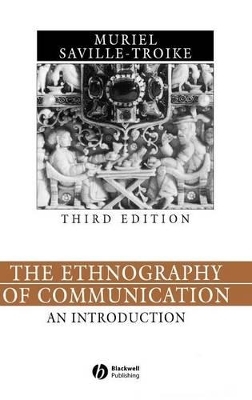
The Ethnography of Communication
Wiley-Blackwell (Verlag)
978-0-631-22841-7 (ISBN)
The Ethnography of Communication presents the terms and concepts which are essential for discussing how and why language is used and how its use varies in different cultures.
Presents the essential terms and concepts introduced and developed by Dell Hymes and others and surveys the most important findings and applications of their work.
Draws on insights from social anthropology and psycholinguistics in investigating the patterning of communicative behavior in specific cultural settings.
Includes two completely new chapters on contrasts in patterns of communication and on politeness, power, and politics.
Incorporates a broad range of examples and illustrations from many languages and cultures for analyzing patterns of communicative phenomena.
Muriel Saville-Troike is Professor in the Department of English at the University of Arizona. She is author of Bilingual Children (1975), Foundations for Teaching English as a Second Language (1976), A Guide to Culture in the Classroom (1978), and co-editor of Perspectives on Silence (with Deborah Tannen, 1985).
Preface. 1. Introduction:.
Scope and Focus.
Method.
Historical Background.
Significance.
Organization of the Book.
2. Basic Terms, Concepts, and Issues:.
Patterns of Communication.
Communicative Functions.
Speech Community.
Communicative Competence.
The Competence of Incompetence.
Units of Analysis.
Categories of Talk.
Language and Culture.
Social Structure and Ideology.
Routines and Rituals.
Universals and Inequalities.
3. Varieties of Language:.
Language Choice.
Diglossia and Dinomia.
Code-Switching and Style-Shifting.
Code-Markers.
Varieties Associated with Setting.
Varieties Associated with Activity Domain.
Varieties Associated with Region.
Varieties Associated with Ethnicity.
Varieties Associated with Social Class, Status, and Role.
Varieties Associated with Role-Relationships.
Varieties Associated with Sex.
Varieties Associated with Age.
Varieties Associated with Personality States and ‘Abnormal’ Speech.
Non-Native Varieties.
4. The Analysis of Communicative Events:.
Relationship of Ethnographer and Speech Community.
Types o f Data.
Survey of Data Collection and Analytic Procedures.
Identification of Communicative Events.
Components of Communication.
Relationship among Components.
Elicitation within a Frame.
Analysis of Interaction.
Sample Analyses of Communicative Events.
Further Illustrations of Ethnographic Analysis.
5. Contrasts in Patterns of Communication:.
Comparative Rhetoric.
Historical Development.
Ethnographic Perspective.
Establishing Validity.
Situated Event Analysis.
Other Data Collection and Analytic Procedures.
Cross-Cultural Communication.
Concepts of ‘Face’;.
Constructing an Unseen Face.
6. Attitudes toward Communicative Performance:.
Methodology.
Attitudes Toward Language and Language Skills.
Attitudes Toward Languages and Varieties.
Stereotyping.
Appropriateness.
Language and Identity.
Language Maintenance, Shift, and Spread.
Taboos and Euphemisms.
7. Acquisition of Communicative Competence:.
Early Linguistic Development.
Social Interaction.
Language and Enculturation.
Definition of Stages and Roles.
Communicative Strategies.
Formulaic Expressions.
Nonverbal Communication.
Peer Influence and Extended Acquisition..
Speech Play.
Formal Education.
Multilingual Contexts..
Children’s Beliefs about Language.
8. Politeness, Power, and Politics:.
Language and Politics.
Language and Social Theories.
Linguistic Signs of Power.
Linguistic Performances of Power.
Linguistic Resistance and Rebellion.
Language Planning.
Responsibilities and Limitations.
9. Conclusion:.
References.
Index of Languages.
General Index.
| Erscheint lt. Verlag | 29.11.2002 |
|---|---|
| Reihe/Serie | Language in Society |
| Verlagsort | Hoboken |
| Sprache | englisch |
| Maße | 158 x 237 mm |
| Gewicht | 626 g |
| Themenwelt | Geisteswissenschaften ► Philosophie ► Sprachphilosophie |
| Geisteswissenschaften ► Sprach- / Literaturwissenschaft ► Sprachwissenschaft | |
| Sozialwissenschaften ► Ethnologie | |
| Sozialwissenschaften ► Kommunikation / Medien ► Kommunikationswissenschaft | |
| Sozialwissenschaften ► Soziologie ► Mikrosoziologie | |
| ISBN-10 | 0-631-22841-1 / 0631228411 |
| ISBN-13 | 978-0-631-22841-7 / 9780631228417 |
| Zustand | Neuware |
| Haben Sie eine Frage zum Produkt? |
aus dem Bereich


